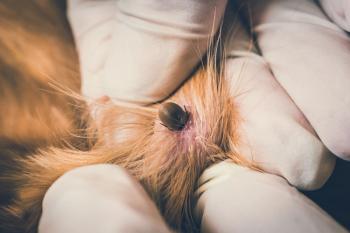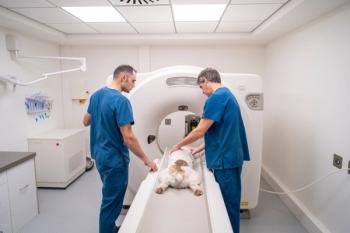
The hyperthyroid cat with renal disease (Proceedings)
Hyperthyroidism and chronic kidney disease are two common diseases of older cats. They may occur separately or in the same animal.
Hyperthyroidism and chronic kidney disease are two common diseases of older cats. They may occur separately or in the same animal. Because of significant overlap in the clinical presentation it can be difficult to differentiate between the two. The following is a brief discussion of the two diseases, diagnosis and treatment as well as recommendations on the identification and treatment of cats with chronic kidney disease and hyperthyroidism.
Diagnostic dilemma
Common historical findings include weight loss, vomiting, diarrhea, increased water consumption and increased urination. With hyperthyroidism the appetite and activity tend to be increased whereas cats with chronic kidney disease have normal to decreased appetites and activity levels. Apathetic hyperthyroidism has been described as a rare, likely more advanced, stage of hyperthyroidism in which the appetite may be depressed and the cat is more lethargic.
On clinical evaluation cats with hyperthyroidism and chronic kidney disease may have a poor hair coat, skin tent, generalized muscle wasting, tacky mucous membranes, tachycardia, a heart murmur, hypertension, and weakness. Cats with chronic kidney disease may have bilaterally palpable small kidneys or one small and one larger kidney. The kidneys in cats with hyperthyroidism should be normal in size but some cats with concurrent early kidney disease may have small kidneys. Almost all cats with hyperthyroidism have a palpable nodule. Unfortunately we have all tested cats with 'thyroid nodules' only to find they were euthyroid.
On laboratory evaluation, the CBC may be normal with both conditions but anemia is common with more advanced forms of chronic kidney disease. Elevations in liver enzymes are common with hyperthyroidism and not seen with chronic kidney disease. Azotemia can be seen with both conditions. In hyperthyroidism, azotemia may be prerenal or they may have concurrent chronic kidney disease. Electrolyte abnormalities (hyperphosphatemia and hypokalemia) are more specific for chronic kidney disease. Urine concentrating ability may be decreased in both disorders. Repeatable isosthenuria (s.g. 1.008 – 1.012) is a feature of kidney disease whereas with hyperthyroidism urine specific gravity can be variable but is usually greater than isosthenuric. Problematic is that with early kidney disease urine may not be isosthenuric as there may be loss of nephrons but enough remaining functional nephrons to concentrate urine to some degree.
The diagnosis of hyperthyroidism is typically made based on the historical, physical and clinical findings mentioned previously in addition to evaluation of serum total thyroxine (TT4) levels. Serum TT4, diagnostic in about 90% of cats with hyperthyroidism, can be affected by the quantity of carrier proteins, alterations in metabolism, the ability to transport thyroxine into cells, and binding of T4 within the cells. These are the mechanisms that may alter TT4 levels in non-thyroidal illness and are the basis for the recommendation of measurement of free T4. Free T4 is what is available for entry into cells so may be a more accurate reflection of thyroid gland function. Tests using equilibrium dialysis (ed) are recommended because other methodologies usually underestimate free T4. A free T4 is able to identify 95% of hyperthyroid cats with a TT4 within the reference range. This test is more sensitive than TT4 for diagnosing hyperthyroidism but is also less specific. This decreased specificity is why it is not recommended as a screening test. In fact in a study looking at FT4 (ed) in sick cats there were some euthyroid cats that were severely ill with elevated FT4 (ed). So illness, including chronic kidney disease, could decrease measureable TT4 (masking hyperthyroidism) and increase FT4 (ed) leading to a misdiagnosis if hyperthyroidism.
Diagnostic tests
Hyperthyroidism should be identified with the clinical findings and an increased TT4 but occasionally the TT4 might be in the normal range. Other tests that are used to differentiate euthyroid from hyperthyroid cats are the T3 suppression test and radionuclide imaging. The T3 suppression test is easy to perform and will not adversely affect the kidneys. Thyroid scintigraphy with pertechnetate can also be utilized to image the thyroid glands or ectopic thyroid tissue. There are also stimulation tests using thyrotropin-releasing hormone (TRH) and thyroid-stimulating hormone (TSH) that are described but TRH and TSH are not readily available and these test can be more difficult to interpret.
Chronic kidney disease occurs as a result of irreversible nephron loss. If persistent azotemia and isosthenuria are present the diagnosis is straight forward. Unfortunately urine concentrating ability may be lost prior to the development of azotemia. This is believed to be due to differences in the amount of nephrons lost. These cases are the most problematic to diagnose and pose a particular problem when working up a case of polyuria and polydipsia. Tests of glomerular filtration rate (GFR) are commonly utilized to determine whether significant nephron loss has occurred. These are plasma and urine clearance tests as well as radionuclide imaging. Te clearance tests used most commonly in clinical practice include exogenous creatinine and iohexol clearance tests. Nuclear scintigraphy utilizing pertechnetate can also be utilized to determine GFR.
My diagnostic recommendation is to perform a CBC, biochemical panel, urinalysis, TT4, and blood pressure on all cats with the historical and clinical findings described. In most instances the diagnosis will be straight forward. If the TT4 is elevated and the signs fit, the cat is hyperthyroid. If the BUN and creatinine are increased, and the urine isosthenuric, chronic kidney disease is present. If the TT4 is increased and just the BUN increased or the BUN and creatinine high normal with urine that is less than maximally concentrated (> 1.030) then this might be a cat with just hyperthyroidism or hyperthyroidism and kidney disease. Elevated kidney values may be due to prerenal factors as well as increases in renal blood flow and GFR secondary to increased thyroid hormones. I do not typically perform tests of GFR in these cats.
Treatment recommendations
Thyroid hormones affect the cardiovascular system by increased cardiac contractility and vascular tone. This increases systemic pressures and renal blood flow. This increase in blood flow and subsequent GFR can be detrimental to the kidneys and lead to vascular remodeling and glomeruloslcerosis. This is the diagnostic and therapeutic dilemma in hyperthyroid cats. What are effects on excess thyroid hormones on systemic blood pressure and kidney function? And if thyroid hormones are decreased what will happen to kidney function?
In a study of 15 hyperthyroid cats, GFR was measured using exogenous creatinine and iohexol 1 day before, 4 weeks following, 12 weeks following, and 24 weeks following radioiodine therapy. There was a significant decrease in GFR in all cats up to 4 weeks with lesser decreases after 4 weeks. Two cats that were azotemic prior to treatment remained azotemic but 7 more cats became azotemic by 24 weeks (6/7 at 12 weeks). In another study 46 hyperthyroid cats were evaluated before and after radioiodine for predictors of development of kidney disease. In this study cats with a lower GFR and higher creatinine prior to radioiodine are more likely to develop kidney disease after treatment. Unfortunately as you can see from these studies some cats with normal kidney values prior to treatment develop evidence of kidney disease after treatment. This is the basis of the following recommendations.
Recall there are reversible and irreversible treatments for hyperthyroidism. Methimazole and carbimazole are reversible whereas thyroidectomy and radioactive iodine are irreversible. Methimazole and carbimazole are reversible inhibitors of iodide organification and the formation of T3 and T4 . Methimazole is used in the US more commonly than carbimazole primarily because of longer duration of effect of methimazole. Carbimazole now has an extended release formulation available so it can be given twice daily and is reported to have fewer side effects. They can also be used prior to surgery or radioactive iodine to stabilize patients. These drugs are useful in long term treatment of hyperthyroidism as well as short term management while determining a cat's tolerance to a euthyroid state. Typically cats are started at 2.5 mg once or twice daily for two weeks and then increased in 2.5 mg/day increments every 2 weeks until TT4 levels are low normal.
The current recommendation is to treat all cats with methimazole or carbimazole for a minimum of 12 weeks of euthyroidism. During this time kidney values and urine should be evaluated for changes suggestive of renal disease. If there is no evidence of deterioration in kidney function then permanent therapy can be considered.
In cats with hypertension a similar approach is used. If the systolic blood pressure is consistently > 180 mmHg anti-hypertensives should also be utilized. Calcium channel blockers are more effective than ACE inhibitors alone. For the same reason the kidneys are monitored with treatment for hyperthyroidism, kidneys should be monitored during treatment for hypertension.
If treatment for hyperthyroidism or hypertension results in worsening of, or the development of, kidney disease then the treatment for hyperthyroidism must be balanced with deteriorating kidney function. This may require compromising some degree of control over the thyroid disease or high blood pressure in order to optimize kidney function. In some instances hyperthyroidism or hypertension may have been exacerbating kidney disease so there might be improvement in kidney function with treatment.
Summary
The diagnosis of hyperthyroidism is relatively straight forward but the diagnosis of concurrent kidney disease may not be. In addition, the effects of decreasing GFR with treatment of hyperthyroidism and concurrent hypertension may be detrimental to the kidneys. For this reason, a trial period with a reversible form of treatment for thyrotoxicosis is recommended with concurrent monitoring of renal function.
References
Edinboro CH, Scott-Montcrieff JC, et al. Epidemiologic study of relationships between consumption of commercial canned food and risk of hyperthyroidism in cats. J Am Vet Med Assoc. 2004 Mar;224(6):879-86.
Feldman EC, Nelson RW. Feline hyperthyroidism (thyrotoxicosis) in Canine and Feline Endocrinology and Reproduction, 3rd ed. Feldman EC, Nelson RW eds. 2004.pp 152 – 218.
Hammer KB, Holt DE, Ward CR. Altered expression of G proteins in thyroid gland adenomas obtained from hyperthyroid cats. Am J Vet Res. 2000 Aug;61(8):874-9.
Kass PH, Peterson ME, et al. Evaluation of environmental, nutritional, and host factors in cats with hyperthyroidism. J Vet Intern Med. 1999 Jul-Aug;13(4):323-9.
Kemppainen RJ, Birchfield JR. Measurement of total thyroxine concentration in serum from dogs and cats by use of various methods. Am J Vet Res 2006 Feb;67(2):259-65.
Lurye JC, Behrend EN, Kemppainen RJ. Evaluation of an in-house enzyme-linked immunosorbant assay for quantitative measurement of serum total thyroxine concentration in dogs and cats. J Am Vet Med Assoc 2002 Sep 1;221(5):631-2.
Martin KM, Rossing MA, et al. Evaluation of dietary and environmental risk factors for hyperthyroidism in cats. J Am Ve Med Assoc. 2000 Sep 15;217(6):853-6.
Mooney CT, Little JL, Macrae AW. Effect of illness not associated with the thyroid gland on serum total and free thyroxine concentrations in cats. J Am Vet Med Assoc 1996 Jun 15;208(12):2004-8.
Morrison J, Jergens A, et al. Comparison of models for predicting renal disease following !-131 therapy for feline hyperthyroidism. J Vet Int Med 2010;22(4):Abstr # 242. pp 744-5.
Morrison J, Jergens A, et al. Investigation of prognostic factors for the development of renal disease following !-131 therapy for feline hyperthyroidism. J Vet Int Med 2010;22(4):Abstr # 243. pp 745.
Olczak J, Jones BR, et al. Multivariate analysis of risk factors for feline hyperthyroidism in New Zealand. N Z Vet J. 2005 Feb;53(1):53-8.
Peeters ME, Timmermans-Sprang EP, Mol JA. Feline thyroid adenomas are in part associated with mutations in the G(s alpha) gene and not with polymorphisms found in the thyrotropin receptor. Thyroid. 2002 Jul;12(7)571-5.
Peterson ME. Diagnostic methods for hyperthyroidism in Consultations in Feline Internal Medicine Vol 5. August J ed. 2006. pp191 – 198.
Peterson ME, Becker DV. Radioiodine treatment of 524 cats with hyperthyroidism. J Am Vet Med Assoc 1995 Dec 1;207(11):1422-8.
Peterson ME, DeMarco CL, Sheldon KM. Total thyroxine testing: comparison of an in-house test kit with radioimmuno- and chemiluminescent assays. J Vet Int Med 2003 May-Jun;17(3):396.
Peterson ME, Gamble DA. Effect of nonthyroidal illness on serum thyroxine concentrations in cats: 494 cases. J Am Vet Med Assoc 1990 Nov 1;197(9):1203-8.
Peterson ME, Graves TK, Cavanagh I. Serum thyroid hormone concentrations fluctuate in cats with hyperthyroidism. J Vet Int Med 1987 Jul-Sep;1(3):142-6.
Peterson ME, Melian C, Nichols R. Measurement of serum concentrations of free thyroxine, total thyroxine, and total triiodothyronine in cats with hyperthyroidism and cats with nonthyroidal disease. J Am Vet Med Assoc 2001 Feb 15;218(4):529-36.
Van Hock I, Lefebvre HF, et al. Plasma clearance of exogenous creatinine, exo-iohexol, and endo-iohexol in hyperthyroid cats before and after treatment with radioiodine. J Vet Int Med 2008;22(4):879-885.
Newsletter
From exam room tips to practice management insights, get trusted veterinary news delivered straight to your inbox—subscribe to dvm360.




